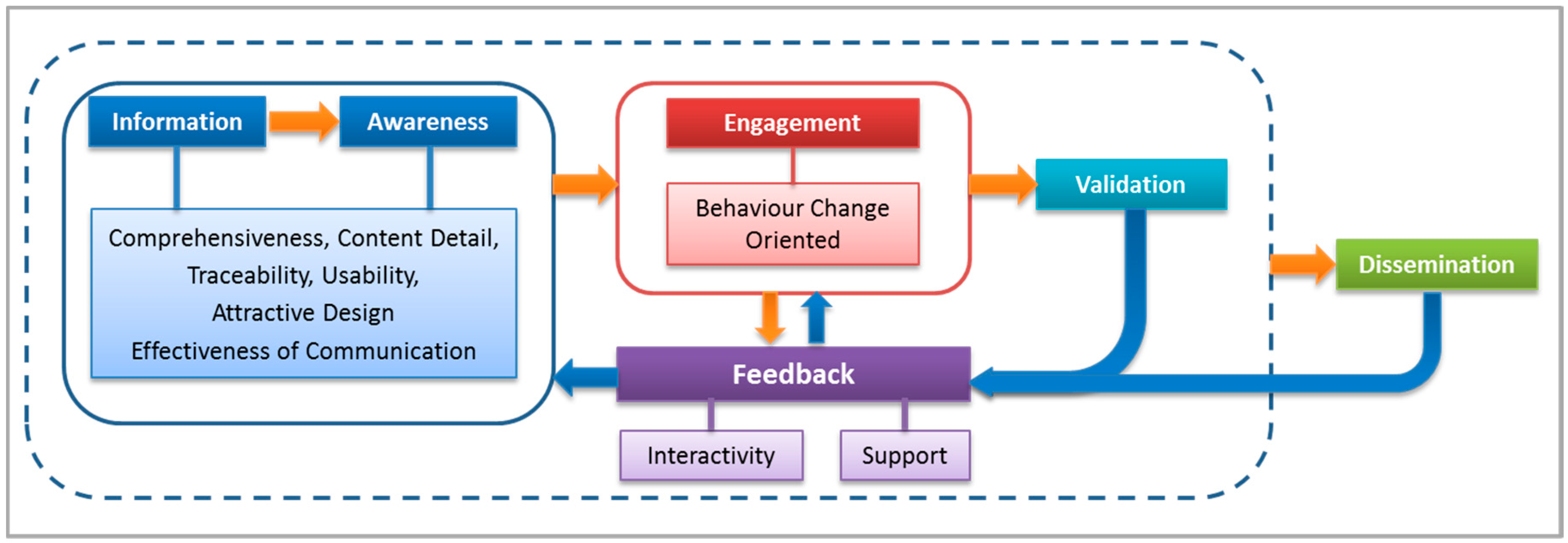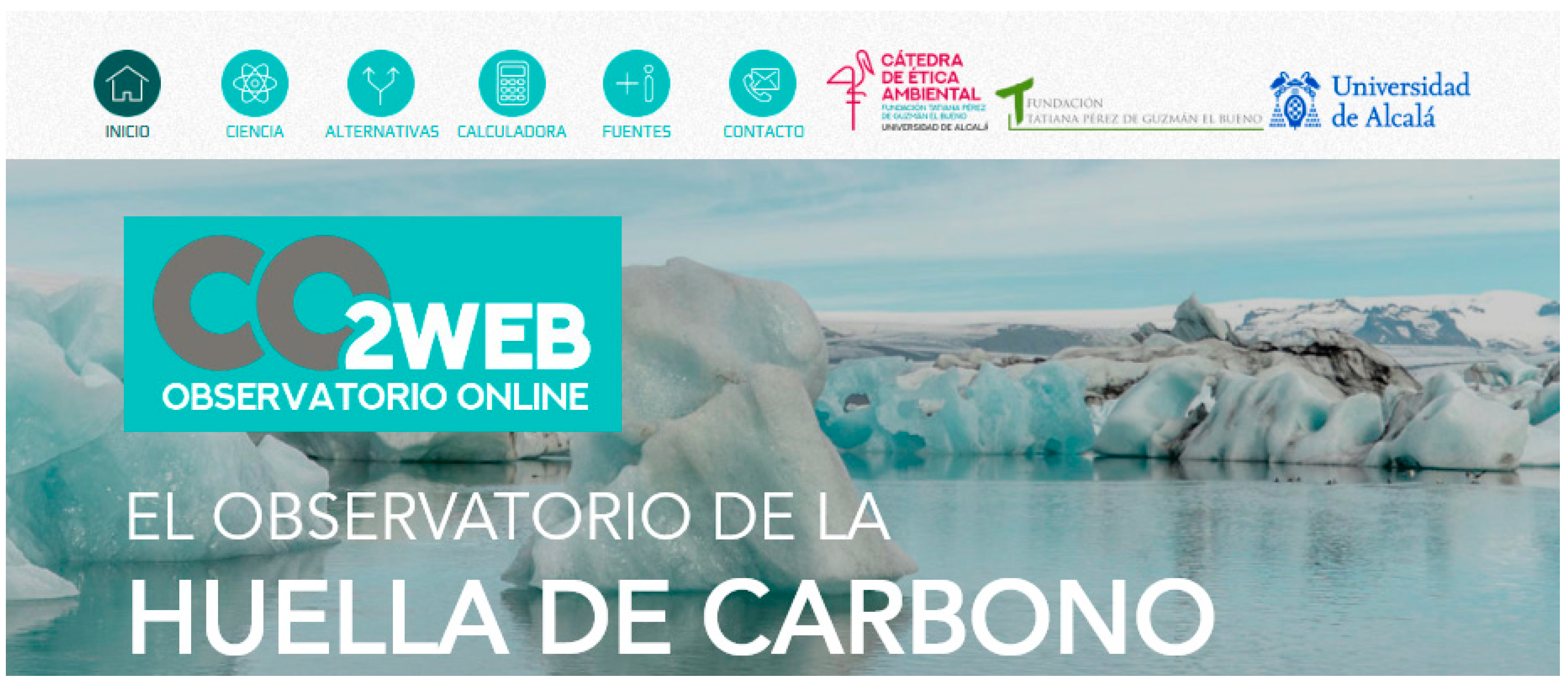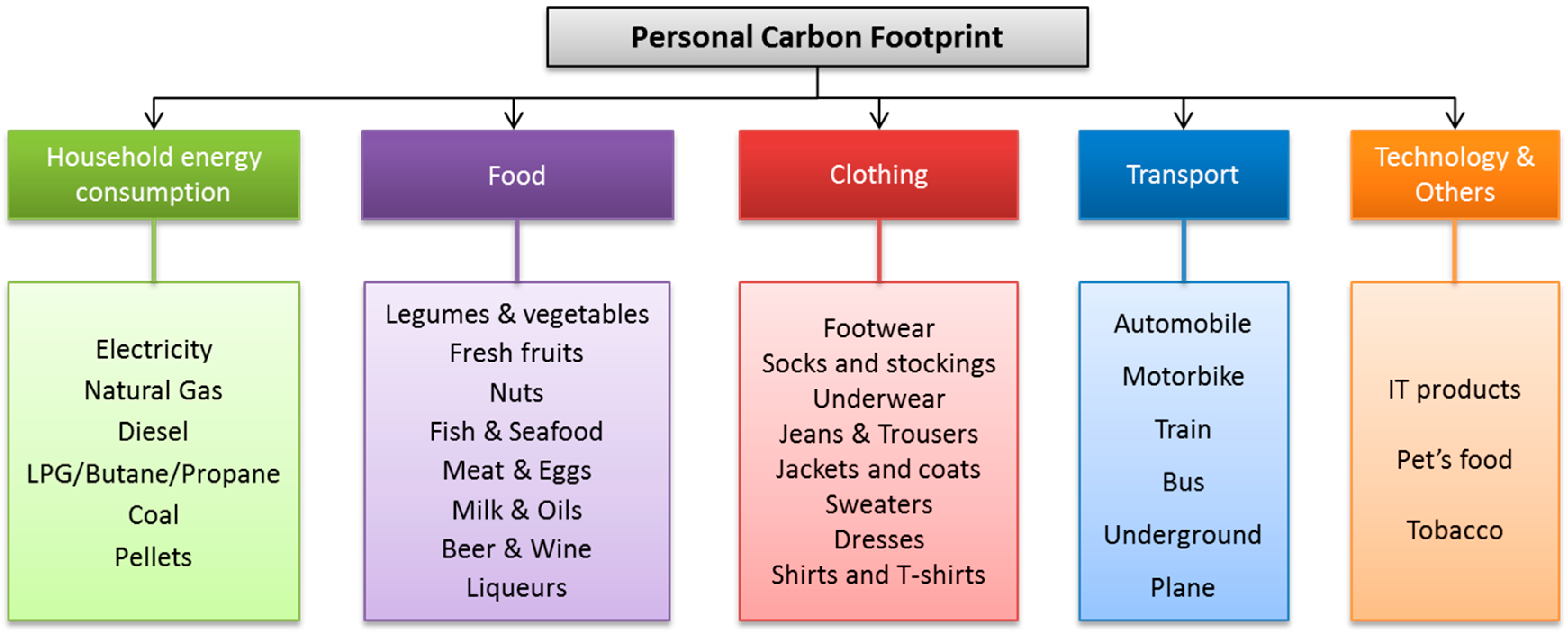Beyond Carbon Footprint Calculators. New Approaches for Linking Consumer Behaviour and Climate Action
Abstract
1. Introduction
2. Objectives
3. Materials and Methods
3.1. Design of the CO2web Observatory
3.1.1. Meeting Conceptual Requirements
- Information: science-driven, data based on solid sources, whenever possible in the peer-reviewed literature.
- Comprehensiveness: include a wide variety of sectors related to personal consumption (those with the greatest impact on GHG emissions).
- Content detail: provide a proper level of detail and options for the different categories. Equilibrium between being too general to provide just a general estimation of emissions, and being too specific as to make greatly complex to fill the input data.
- Traceability: all data included in the observatory should be properly referenced.
- Interactivity: facilitate interaction with the user.
- Usability: easy access and operation. Handy features and explanations facilitate navigation and use. Functional diversity has been considered.
- Attractive design: good aesthetic, user-friendly colors and icons. Adapted to all devices.
- Awareness: beyond the information, it was considered essential to make the user aware about the importance of the topic (climate change as the main current environmental challenge) and his or her individual contribution (through the acquisition of more sustainable habits).
- Behavior change oriented: comparisons between different options and alternative “low carbon” products, diets or transports; general and personalized suggestions to reduce personal carbon footprint.
- Effectiveness of communication: parsing and communicating emissions with different levels of detail, both grouped and disaggregated.
- Support: give guidance and answer questions from users.
- Feedback: collect user’s opinion and suggestions to improve.
- Dissemination: open to ordinary citizens, no specialized audiences.
3.1.2. Technical Requirements
3.2. Target Information of the CO2web Observatory
3.3. Programming
3.4. Validation
4. Results and Discussion
4.1. Contents
 | Why an observatory? Includes the background for creating the site and general recommendations for its use. |
 | Science: describes the scientific bases of climate change, the concept of CF and its calculation. |
 | Alternatives: includes emissions information on a wide variety of dimensions of personal consumption. |
 | Calculator: includes a personal calculator of the CF. |
4.1.1. Science
4.1.2. Alternatives
4.1.3. CFC
4.2. Validation
4.2.1. Compliance with User Requirements
4.2.2. Compliance with Technical Requirements
4.2.3. Students Feedback
- “I found this work very useful. I was able to check my CF and become more aware of the emissions we emit over the course of a year. This concept should be more present in our day to day lives”.
- “My footprint has been XX kgCO2e, a very high one in relation to the rest of my colleagues because last summer I traveled to XXX, which has increased my emissions a lot”.
- “Finally, is transport where the most CO2 emissions are registered compared to the total, because I am below the average in practically in the rest of the sections. The fact of studying and working at the same time implies higher than average emission values”.
- “The population should have more information about our HC and thus, little by little, create a new lifestyle with small gestures and try to reduce it”.
- “This type of technology is very interesting, since many people could see the environmental disaster they may be causing. Let ideas like this proliferate to continue educating people”.
4.3. Difficulties and Limitations
4.4. Accesibility
5. Conclusions and Future Work
Author Contributions
Funding
Acknowledgments
Conflicts of Interest
References
- Stocker, T.F.; Qin, D.; Plattner, G.-K.; Tignor, M.; Allen, S.K.; Boschung, J.; Nauels, A.; Xia, Y.; Bex, V.; Midgley, P.M. Climate Change 2013—The Physical Science Basis; Contribution of Working Group i to the Fifth Assessment Report of the Intergovernmental Panel on Climate Change; Cambridge University Press: Cambridge, UK, 2013; p. 1535. [Google Scholar]
- Victor, D.G.; Akimoto, K.; Kaya, Y.; Yamaguchi, M.; Cullenward, D.; Hepburn, C. Prove paris was more than paper promises. Nat. News 2017, 548, 25. [Google Scholar] [CrossRef]
- Hertwich, E.G.; Peters, G.P. Carbon footprint of nations: A global, trade-linked analysis. Environ. Sci. Technol. 2009, 43, 6414–6420. [Google Scholar] [CrossRef] [PubMed]
- Ivanova, D.; Stadler, K.; Steen-Olsen, K.; Wood, R.; Vita, G.; Tukker, A.; Hertwich, E.G. Environmental impact assessment of household consumption. J. Ind. Ecol. 2016, 20, 526–536. [Google Scholar] [CrossRef]
- Paterson, M.; Stripple, J. My space: Governing individuals’ carbon emissions. Environ. Plan. D Soc. Space 2010, 28, 341–362. [Google Scholar] [CrossRef]
- Collins, A.; Galli, A.; Hipwood, T.; Murthy, A. Living within a one planet reality: The contribution of personal footprint calculators. Environ. Res. Lett. 2020, 15, 025008. [Google Scholar] [CrossRef]
- Salo, M.; Mattinen-Yuryev, M.K.; Nissinen, A. Opportunities and limitations of carbon footprint calculators to steer sustainable household consumption—analysis of nordic calculator features. J. Clean. Prod. 2019, 207, 658–666. [Google Scholar] [CrossRef]
- Birnik, A. An evidence-based assessment of online carbon calculators. Int. J. Greenh. Gas Control 2013, 17, 280–293. [Google Scholar] [CrossRef]
- Mulrow, J.; Machaj, K.; Deanes, J.; Derrible, S. The state of carbon footprint calculators: An evaluation of calculator design and user interaction features. Sustain. Prod. Consum. 2019, 18, 33–40. [Google Scholar] [CrossRef]
- Gram-Hanssen, K.; Christensen, T.H. Carbon calculators as a tool for a low-carbon everyday life? Sustain. Sci. Prac. Policy 2012, 8, 19–30. [Google Scholar] [CrossRef]
- Büchs, M.; Bahaj, A.S.; Blunden, L.; Bourikas, L.; Falkingham, J.; James, P.; Kamanda, M.; Wu, Y. Promoting low carbon behaviours through personalised information? Long-term evaluation of a carbon calculator interview. Energy Policy 2018, 120, 284–293. [Google Scholar] [CrossRef]
- Mallett, R.K.; Melchiori, K.J.; Strickroth, T. Self-confrontation via a carbon footprint calculator increases guilt and support for a proenvironmental group. Ecopsychology 2013, 5, 9–16. [Google Scholar] [CrossRef]
- Shirley, R.; Jones, C.; Kammen, D. A household carbon footprint calculator for islands: Case study of the united states virgin islands. Ecol. Econ. 2012, 80, 8–14. [Google Scholar] [CrossRef]
- Pandey, D.; Agrawal, M.; Pandey, J.S. Carbon footprint: Current methods of estimation. Environ. Monit. Assess. 2013, 178, 135–160. [Google Scholar] [CrossRef] [PubMed]
- Weidema, B.P.; Thrane, M.; Christensen, P.; Schmidt, J.; Løkke, S. Carbon footprint. J. Ind. Ecol. 2008, 12, 3–6. [Google Scholar] [CrossRef]
- Padgett, J.P.; Steinemann, A.C.; Clarke, J.H.; Vandenbergh, M.P. A comparison of carbon calculators. Environ. Impact Assess. Rev. 2008, 28, 106–115. [Google Scholar] [CrossRef]
- Kenny, T.; Gray, N. Comparative performance of six carbon footprint models for use in ireland. Environ. Impact Assess. Rev. 2009, 29, 1–6. [Google Scholar] [CrossRef]
- Rahman, F.; O’Brien, C.; Ahamed, S.I.; Zhang, H.; Liu, L. Design and implementation of an open framework for ubiquitous carbon footprint calculator applications. Sustain. Comput. Inform. Syst. 2011, 1, 257–274. [Google Scholar] [CrossRef]
- Kim, B.; Neff, R. Measurement and communication of greenhouse gas emissions from us food consumption via carbon calculators. Ecol. Econ. 2009, 69, 186–196. [Google Scholar] [CrossRef]
- Salo, M.; Mattinen, M.K. Carbon Footprint Calculators for Citizens: Recommendations and Implications in the Nordic Context; Nordic Countil of Ministers: Copenhagen, Denmark, 2017. [Google Scholar]
- Clayton, S.; Myers, G. Conservation Psychology: Understanding and Promoting Human Care for Nature; John Wiley & Sons: Chichester, UK, 2015. [Google Scholar]
- Hill, N.; Bonifazi, E.; Bramwell, R.; Karagianni, E.; Harris, B. 2018 Government GHG Conversion Factors for Company Reporting. Methodology Paper for Emission Factors: Final Report; Department for Business Energy & Industrial Strategy. UK Government: London, UK, 2018; p. 141.
- Biørn-Hansen, A. Evaluation of a Carbon Calculator: Challenges and Opportunities with Calculating Emissions from Consumption Behaviour. Master’s Thesis, University of Gothenburg, Gothenburg, Sweden, 2019. [Google Scholar]
- West, S.E.; Owen, A.; Axelsson, K.; West, C.D. Evaluating the use of a carbon footprint calculator: Communicating impacts of consumption at household level and exploring mitigation options. J. Ind. Ecol. 2016, 20, 396–409. [Google Scholar] [CrossRef]
- Myhre, G.; Shindell, D.; Bréon, F.; Collins, W.; Fuglestvedt, J.; Huang, J.; Koch, D.; Lamarque, J.; Lee, D.; Mendoza, B. Anthropogenic and natural radiative forcing. In Climate Change 2013: The Physical Science Basis; Contribution of Working Group i to the Fifth Assessment Report of the Intergovernmental Panel on Climate Change; Cambridge University Press: Cambridge, UK, 2013; pp. 659–740. [Google Scholar]
- ADEME. Agribalyse Program; French Environment & Energy Management Agency: Angers, France, 2018.
- MFVM. Carbon Footprint Data; The Danish Ministry of Food, Agriculture and Fisheries: Copenhagen, Denmark, 2009.
- Chuvieco, E.; Burgui, M.; Carrero, I.; Díaz, E.; Labajo, V.; Valor, C.; López, R. Cálculo y Etiquetado de la Huella de Carbono en Productos Alimentarios; Catedra de Etica Ambiental FTPGB-UAH: Alcala de Henares, Spain, 2018; p. 36. [Google Scholar]
- Zafeiridou, M.; Hopkins, N.S.; Voulvoulis, N. Cigarette smoking: An assessment of tobacco’s global environmental footprint acrossits entire supply chain. Environ. Sci. Technol. 2018, 52, 8087–8094. [Google Scholar] [CrossRef]
- ICAO. Carbon Emissions Calculator; International Civil Aviation Organization: Montreal, QC, Canada, 2016. [Google Scholar]
- IDAE. Estudios, Informes y Estadísticas; Instituto para la Diversificación y Ahorro de la Energía. Ministerio para la Transición Ecológica: Madrid, Spain, 2017.
- Peters, J.F.; Baumann, M.; Zimmermann, B.; Braun, J.; Weil, M. The environmental impact of li-ion batteries and the role of key parameters—A review. Renew. Sustain. Energy Rev. 2017, 67, 491–506. [Google Scholar] [CrossRef]
- MITECO. Herramientas Para el Cálculo de la Huella de Carbono; Ministerio para la Transición Ecológica. Gobierno de Espana: Madrid, Spain, 2018.
- OCCC. Guía Práctica Para el Cálculo de Emisiones de Gases de Efecto Invernadero; Oficina Catalana del Cambio Climatico: Barcelona, Spain, 2020; p. 127. [Google Scholar]
- Cheah, L.; Duque Ciceri, N.; Olivetti, E.; Matsumura, S.; Forterre, D.; Roth, R.; Kirchain, R. Manufacturing-focused emissions reductions in footwear production. J. Clean. Prod. 2013, 44, 18–29. [Google Scholar] [CrossRef]
- INESCOOP. Footwear Carbon Footprint; INESCOOP Center for Technology and Innovation: Elda, Spain, 2017; p. 59. [Google Scholar]
- Munasinghe, M.; Jayasinghe, P.; Ralapanawe, V.; Gajanayake, A. Supply/value chain analysis of carbon and energy footprint of garment manufacturing in sri lanka. Sustain. Prod. Consum. 2016, 5, 51–64. [Google Scholar] [CrossRef]
- Rivera Muñoz, Z. Water, Energy and Carbon Footprints of a Pair of Leather Shoes; KTH Royal Institute of Technology: Stockholm, Sweden, 2013. [Google Scholar]
- Kirchain, R.; Olivetti, E.; Miller, T.R.; Greene, S. Sustainable Apparel Materials; Massachusetts Institute of Technology: Cambridge, MA, USA, 2015; p. 34. [Google Scholar]
- Koehler, A.; Wildbolz, C. Comparing the environmental footprints of home-care and personal-hygiene products: The relevanceof different life-cycle phases. Environ. Sci. Technol. 2009, 43, 8643–8651. [Google Scholar] [CrossRef] [PubMed]
- Francke, I.C.M.; Castro, J.F.W. Carbon and water footprint analysis of a soap bar produced in brazil by natura cosmetics. Water Resour. Ind. 2013, 1–2, 37–48. [Google Scholar] [CrossRef]
- Weir, C.S. In the Red: A Private Economic Cost and Qualitative Analysis of Environmental and Health Implications for Five Menstrual Products; Dalhousie University: Halifax, NS, Canada, 2015. [Google Scholar]
- CoClear. Global Publicly Disclosed Product Carbon Footprints; CoClear: Sydney, Australia, 2019. [Google Scholar]
- Gemechu, E.D.; Butnar, I.; Gomà-Camps, J.; Pons, A.; Castells, F. A comparison of the ghg emissions caused by manufacturing tissue paper from virgin pulp or recycled waste paper. Int. J. Life Cycle Assess. 2013, 18, 1618–1628. [Google Scholar] [CrossRef]
- Carbon Trust. Product Carbon Footprinting: The New Business Opportunity; UK Government: London, UK, 2008; p. 36.
- Belkhir, L.; Elmeligi, A. Assessing ict global emissions footprint: Trends to 2040 & recommendations. J. Clean. Prod. 2018, 177, 448–463. [Google Scholar]
- Kalmykova, Y.; Patrício, J.; Rosado, L.; Berg, P.E. Out with the old, out with the new—The effect of transitions in tvs and monitors technology on consumption and weee generation in sweden 1996–2014. Waste Manag. 2015, 46, 511–522. [Google Scholar] [CrossRef]
- Sikdar, B. A study of the environmental impact of wired andwireless local area network access. IEEE Trans. Consum. Electron. 2013, 59, 85–92. [Google Scholar] [CrossRef]
- Martens, P.; Su, B.; Deblomme, S. The ecological paw print of companion dogs and cats. BioScience 2019, 69, 467–474. [Google Scholar] [CrossRef]
- Su, B.; Martens, P. Environmental impacts of food consumption by companion dogs and cats in Japan. Ecol. Indic. 2018, 93, 1043–1049. [Google Scholar] [CrossRef]
- Su, B.; Martens, P.; Enders-Slegers, M.-J. A neglected predictor of environmental damage: The ecological paw print and carbon emissions of food consumption by companion dogs and cats in China. J. Clean. Prod. 2018, 194, 1–11. [Google Scholar] [CrossRef]
- Myhre, G.; Shindell, D.; Bréon, F.-M.; Collins, W.; Fuglestvedt, J.; Huang, J.; Koch, D.; Lamarque, J.-F.; Lee, D.; Mendoza, B. Anthropogenic and natural radiative forcing. Clim. Chang. 2013, 423, 658–740. [Google Scholar]
- Lin, S.-M. Identify predictors of university students’ continuance intention to use online carbon footprint calculator. Behav. Inf. Technol. 2017, 36, 294–311. [Google Scholar] [CrossRef]
- Bhattacherjee, A. Understanding information systems continuance: An expectation-confirmation model. MIS Q. 2001, 25, 351–370. [Google Scholar] [CrossRef]
- Koo, C.; Chung, N.; Nam, K. Assessing the impact of intrinsic and extrinsic motivators on smart green it device use: Reference group perspectives. Int. J. Inf. Manag. 2015, 35, 64–79. [Google Scholar] [CrossRef]
- Edstrand, E. Making the invisible visible: How students make use of carbon footprint calculator in environmental education. Learn. Med. Technol. 2016, 41, 416–436. [Google Scholar] [CrossRef]



| Requirement | Target | Implemented |
|---|---|---|
| Information | Science-based | All references included proceed from peer-reviewed papers and official institutions. Scientific basis of climate change, the calculation of CF and life cycle analysis are included. |
| Content | Correct equilibrium between comprehensiveness and parsimony | The main sectors of consumption were included: transport (airplane, train, car, bus), food (all categories), clothing, computers and home appliances, cleaning and beauty products, tobacco, pets). |
| Traceability | All data properly referenced | Data were obtained from peer-reviewed papers or databases from reference institutions (National Electrical Grid system, for instance). Each emission data is linked to its source using a hyperlink. The section “additional information” includes the complete list of references. |
| Interactivity | Interaction with the user | All tables can be ordered according to the user’s preference criteria (type of product, origin, number of emissions, etc.), so that the differences can be easily observed. |
| Usability | Easy access and operation | Navigation is minimized to facilitate access to all submenus. Icons were designed to facilitate navigation of people with reduced visibility and functional diversity. The whole content was also adapted to the different devices and operating systems available. |
| Attractive design | Good esthetic | Design an original logo and icons. Warm colors and fonts for the website. |
| Awareness | Make the user realize the importance of climate change and individual acts. | Comparisons of personal CF with people from the same cohort. Individual suggestions based on departure from average emissions of the same cohort |
| Behavior change oriented | Facilitate changing habits | Establishment of comparisons between emissions associated with different activities. The CFC includes comparing the user’s CF with other people with similar characteristics. The CFC report includes personalized recommendations. |
| Support | Easy to introduce user suggestions | Contact link, user questionnaire |
| Dissemination | Open to ordinary citizens, no specialized audiences. | The observatory has been referenced in Newspapers and dedicated media, as well as in national and local radio. Two videos of the site were produced (2 m version to be permanently exposed on the website, and a 20 s version to be distributed by social networks. |
| Feedback | Collect user’s opinion and suggestions to improve. | A brief questionnaire was added once the calculation results were obtained and also in the “contact” section. |
| Requirement | Compliance |
|---|---|
| Yes |
| Yes, following Myhre et al. [52]. |
| Average emission of the Spanish electrical system was obtained from 2018 |
| Outputs indicated total emissions as well as those derived from food, transport, clothing, pets, etc. |
| Yes |
| Yes |
| Yes |
| Yes |
| Yes |
| Yes, outputs are downloadable in both pdf and excel format |
| Yes. Age, Educational level, Size of urban area, sex, profession |
| Yes |
© 2020 by the authors. Licensee MDPI, Basel, Switzerland. This article is an open access article distributed under the terms and conditions of the Creative Commons Attribution (CC BY) license (http://creativecommons.org/licenses/by/4.0/).
Share and Cite
Burgui-Burgui, M.; Chuvieco, E. Beyond Carbon Footprint Calculators. New Approaches for Linking Consumer Behaviour and Climate Action. Sustainability 2020, 12, 6529. https://doi.org/10.3390/su12166529
Burgui-Burgui M, Chuvieco E. Beyond Carbon Footprint Calculators. New Approaches for Linking Consumer Behaviour and Climate Action. Sustainability. 2020; 12(16):6529. https://doi.org/10.3390/su12166529
Chicago/Turabian StyleBurgui-Burgui, Mario, and Emilio Chuvieco. 2020. "Beyond Carbon Footprint Calculators. New Approaches for Linking Consumer Behaviour and Climate Action" Sustainability 12, no. 16: 6529. https://doi.org/10.3390/su12166529
APA StyleBurgui-Burgui, M., & Chuvieco, E. (2020). Beyond Carbon Footprint Calculators. New Approaches for Linking Consumer Behaviour and Climate Action. Sustainability, 12(16), 6529. https://doi.org/10.3390/su12166529






